Top dressing and fertilization of apple trees in spring and summer
Apple trees have been growing in one place for decades, and therefore the soil under them is gradually depleted, which negatively affects the quantity and quality of the crop. Fruit trees, like other crops, need periodic feeding, especially during the active growing season (spring). But not every gardener knows when and how to fertilize correctly.
How to properly feed and what is the best way to fertilize apple trees in spring, in order to always have a bountiful and tasty harvest, read further in this detailed article.
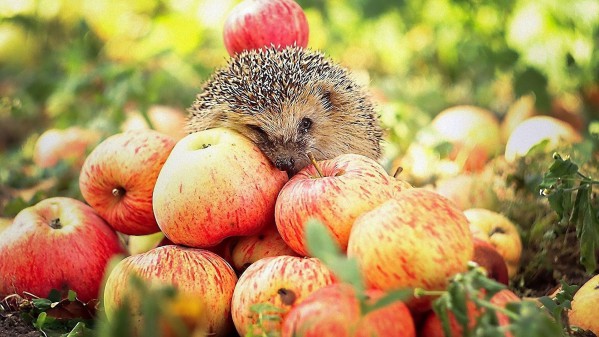
Content
- 1 Why fertilize an apple tree in spring: why do you need spring feeding
- 2 When to fertilize an apple tree in spring: optimal timing and scheme
- 3 How to properly fertilize an apple tree, what types of dressings are there, their specifics
- 4 How to feed an apple tree in spring for a good harvest: options for effective spring fertilizers
- 4.1 Mineral and organic nitrogen fertilizers
- 4.2 Complex (nitrogen-phosphorus-potassium) mineral feeding
- 4.3 Mineral and organic potassium-phosphorus feeding
- 4.4 Rapidly assimilated phosphorus supplement
- 4.5 Autumn potassium-phosphorus fertilizing (after harvest)
- 4.6 Ready-made fertilizers for apple (fruit and berry crops), including fast-digesting and in chelated form
- 4.7 Fertilizers with humates and microelements
- 5 What else needs to be done in the spring to get a good harvest of apples
Why fertilize an apple tree in spring: why do you need spring feeding
Apple, like any other fruit tree, requires a certain nutrition, in other words, the culture needs the whole complex of macro- (nitrogen, phosphorus and potassium) and microelements (the most important are calcium, magnesium, boron, sulfur, copper, zinc, iron, manganese)
Nitrogen - required for active growth (elongation) of shoots and development of leaf apparatus (leaves).
However! You can not overdo it with nitrogen fertilizers and use them only in the spring (before flowering and / or only at the beginning of the fruit growth phase).
Phosphorus - is responsible for the root system of the plant. This means that when and at what time the apple tree will enter the growing season will depend on how much the tree is provided with phosphorus nutrition. The high phosphorus content helps plants to improve the formation of generative organs, flowering and fruit set.
Phosphorus and potash fertilizers, as a rule, are applied in the initial phases of growth, before and during flowering, as well as after fruiting (in autumn).
Potassium - improves carbohydrate metabolism, the processes of filling and ripening fruits, as well as ripening of shoots, increases the plant's immunity, its resistance to frost and drought.
Note! Phosphorus and especially potassium are highly responsible for the resistance of plants to unfavorable growing conditions (drought, frost). In other words, a high-grade potassium-phosphorus nutrition can improve the immunity of an apple tree.
Naturally, the main action is performed by macronutrients, directing metabolic processes towards protein (more nitrogen) or carbohydrate synthesis (more potassium), and microelements improve the absorption and work of macronutrients, thereby stimulating metabolism.
Thus, thanks to timely and high-quality feeding of the apple tree, you will be able to influence the quantity and quality (size, color, taste) of future fruits, increase the plant's immunity and its resistance, and also help to better start the fruit buds, from which the next harvest will be.
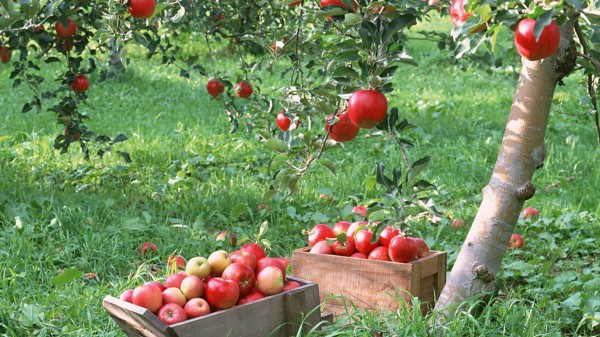
When to fertilize an apple tree in spring: optimal timing and scheme
Apple trees should be fed in the spring according to a certain scheme, so it is extremely important to know when and at what time to fertilize. In this case, it is most convenient to rely on certain phases of plant development.
Many experienced gardeners adhere to the following scheme for feeding the apple tree in spring and summer (after harvest), focusing on the phases of plant development.
First feeding (in early spring before bud break)
The first feeding of the apple tree is carried out in early springwhen a positive temperature is established (the snow begins to actively melt or has already melted) and the tree begins to wake up (its buds are just beginning to swell), that is, after you spend spring pruning of apple trees.
At this point, the plant needs a lot of nitrogen to build up green mass. Ammonium nitrate or urea (the first is better, but the second is also possible) - this is your choice.
Think! On the other hand, in order for potassium and phosphorus to dissolve and "be drawn" by the plant during flowering and fruiting, it is better to apply them right now, therefore, during this period it is convenient to use complex fertilizers such as nitroammophoska or diammofoska.
During the same period, you can mulch the trunk circle with compost or humus (these are excellent organic nitrogen fertilizers of prolonged-long action).
Before flowering
Obviously, in order for the fruits to gain weight and sweetness, they need a sufficient amount of potassium and phosphorus nutrition, however, if you now add potassium sulfate and superphosphate, or even the same nitroammofosk or diammofosk, then the apple tree will not immediately receive the required macronutrients.
However! It is another matter if you use potassium monophosphate, or prepare a special fast-digesting solution. superphosphate (about how to do it, read further in a separate paragraph) or use special fertilizers in a chelated form (Plantafid, Aquarin), then the effect will be immediately.
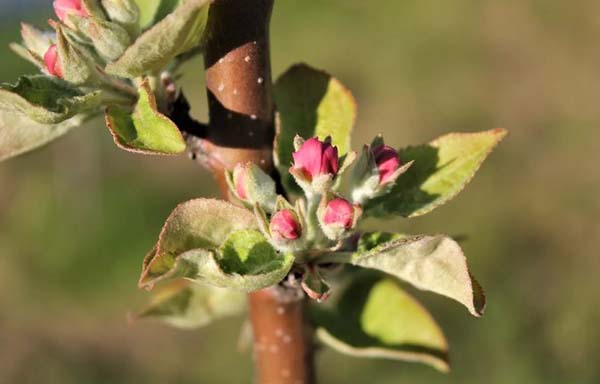
During flowering
If the weather is unfavorable, then improve fruit set very good at the beginning of flowering (we can say that on a pink bud) to hold foliar feeding apple trees by leaf boron... For example, it could be solution boric acid (5-10 grams per 10 liters, although some sources indicate up to 20 grams) or a special drug Boroplus (the name is only similar to the famous cream).
Also, during the flowering period, it is very good to do foliar dressing on the leaf with easily digestible fertilizers with a high phosphorus content (such as Plantafid or Aquarin).
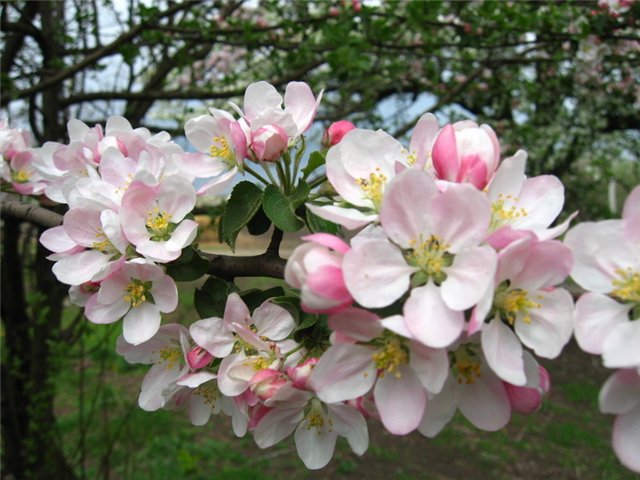
After flowering and at the beginning of ovary formation
If you have not previously applied nitrogenthen now it's time to do it (5-7 days after flowering). Moreover, you can carry out just foliar feeding - spraying the apple tree with a urea solution (20-30 grams per 10 liters), and repeat after 25-30 days. Either apply dry fertilizer to the trunk circle or spill it with a liquid solution.
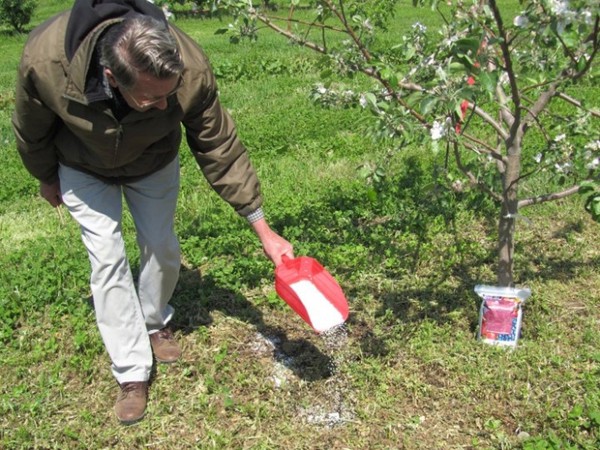
You should not do any more nitrogen fertilization. Strictly until early July.
Also during this period you can use complex fertilizers with macro (with a predominant content of potassium and phosphorus) and trace elements in chelated (digestible) form, producing foliar dressing. For example, the same Plantafid, AgroMaster from the Russian company Agromaster, Aquarin from the Buisk chemical plant.
After fruiting and harvesting (late summer-autumn)
The purpose of the last (autumn) feeding of the apple tree is to make the tree strengthened its root systemso to speak increased winter hardiness (especially it concerns young apple trees, in this case, the trees will be able to more easily withstand strong drops and changes in temperature), and also improved their immunity - resistance to various kinds of diseases.
And finally, the apple tree has laid flower buds = ready for the next harvest.
Therefore, the tree during this period requires phosphorus and potassium (as an option, superphosphate and potassium sulfate or just potassium monophosphate).
By the way! The site has a detailed article about how and what to feed the apple tree after fruiting and harvesting (in the fall).
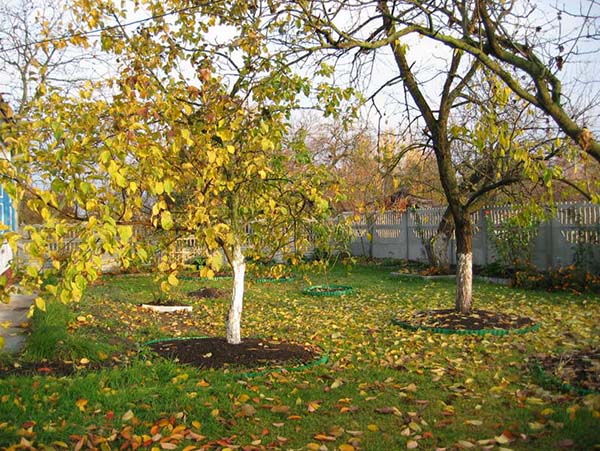
How to fertilize an apple tree correctly, what types of dressings are there, their specificity
Basic rules and recommendations for spring fertilization of apple trees:
- An apple tree planted last year does not need to be fertilized in the spring if sufficient nutrients = fertilizers have been added to the soil during planting.
They begin to feed only after 2-3 years, since only by this time the plants will have pulled out of the soil all the nutrients introduced during their planting.
- When you do root dressing, fertilizer needs to be applied not under the barrel, but necessarily stepping back from the tree by 50-70 cm... It is at this distance that the roots of the tree are located, which you want to provide food (feed). In this case, it is more rational to embed fertilizers (with the help of a hoe, flat cutter) into the soil in small doses, or simply sprinkle it around the perimeter (diameter) of the crown.
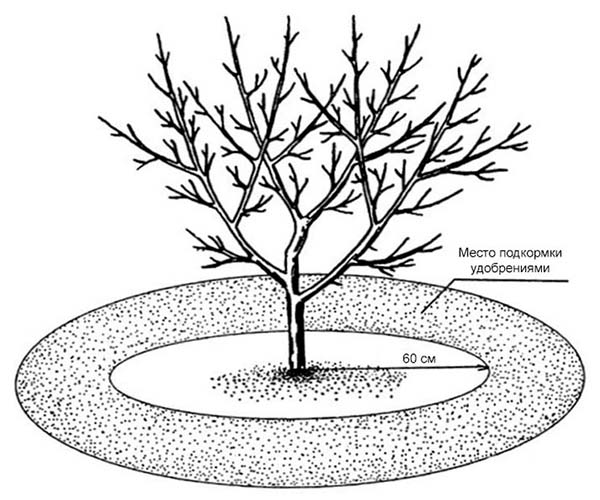
- Before liquid feeding the apple tree, it is recommended to first spill the tree with plain water, because it is always necessary to fertilize on wet soil, especially with mineral fertilizers.
By the way! You can water it a day or 1-2 hours before feeding.
- If during root feeding you get on the leaves and fruits, then try to irrigate (lightly rinse) with plain water.
The fact is that with root top dressing, the fertilizer concentration is much higher (2-3 times) than with foliar top dressing (by leaf).
- Top dressing is desirable in the morning or evening hours, but not at noon, when the sun is at its zenith, or you can choose a cloudy day.
Advice! Any granular mineral fertilizer better pre-dissolve in a separate container in hot water (you can use boiling water), since granules, as a rule, dissolve in cold water rather poorly and slowly.
Methods or types of feeding
Exists 2 ways or type of feeding any plant (including apple trees): root (watering at the root) and foliar (by leaves). Let's take a closer look at each of them.
As a rule, it is in the spring major root dressing... And now closer to summer or summer can be done and foliar feeding (by leaves).
Root dressing
Root top dressing implies the application of fertilizers directly under the root of the plant, namely in the near-stem circle, even more accurately and more correctly - along the perimeter of the crown (near-stem circle, i.e. at least 60 cm away from the stem, and preferably all 80-100 cm).
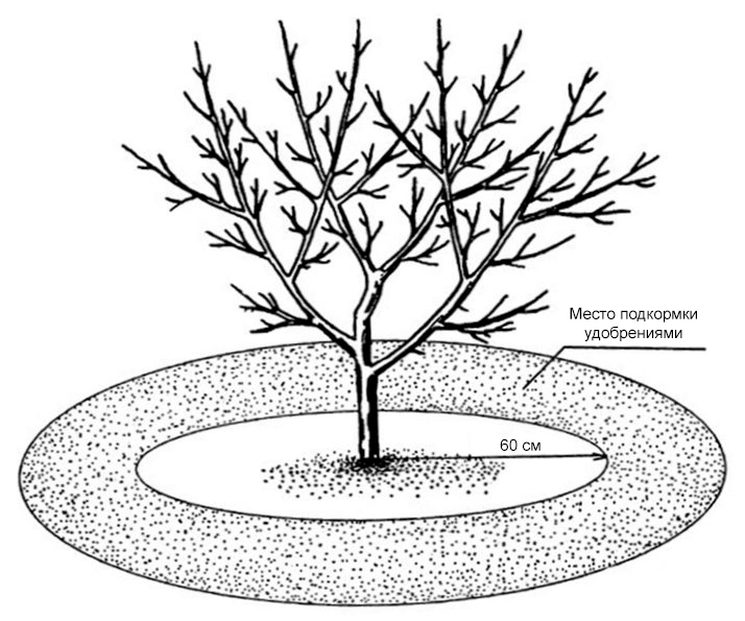
It is recommended to distribute fertilizers along the diameter (perimeter) of the crown of the tree, making small depressions, so to speak, grooves (holes), and then add it with earth, or you can simply put fertilizers into the soil using a hoe or flat cutter.
Alternatively, you can apply a focal (long-term) feeding method, namely, make 10-12 pits 30-40 cm deep around the crown perimeter, in each of which add 200-500 grams of potassium sulfate (sulfate) and superphosphateand then dig in. Such apple fertilization is more than enough for 5-7 years.
Video: focal (long-term) feeding method and express method of feeding an apple tree
Root feeding can be done as in liquid form (i.e. the fertilizer is preliminarily dissolved in water - this way they reach the roots faster), so in dry, i.e. you need to scatter the granules and cover them with earth, and then they will gradually dissolve during watering or rains (this is a longer feeding, i.e. the plant receives nutrition gradually).
By the way! At the same time, dry dressing is convenient to carry out during rainy seasons, for example, in the same autumn or early spring.
However, as for young apple trees, then it is better to feed them liquid solutions.
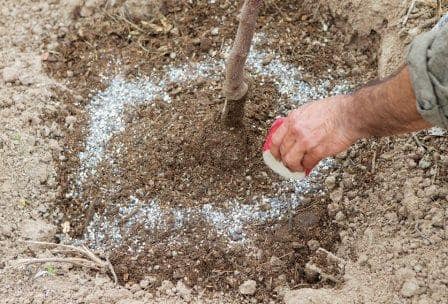
For root dressing, as a rule, mineral fertilizers with macronutrients, as well as organics.
Foliar dressing
You can fertilize apple trees in spring not only at the root, but also on the leaves. In the case of foliar dressing, fertilizers are applied through the aerial part of the tree, that is, through the surface of the leaves by spraying them.
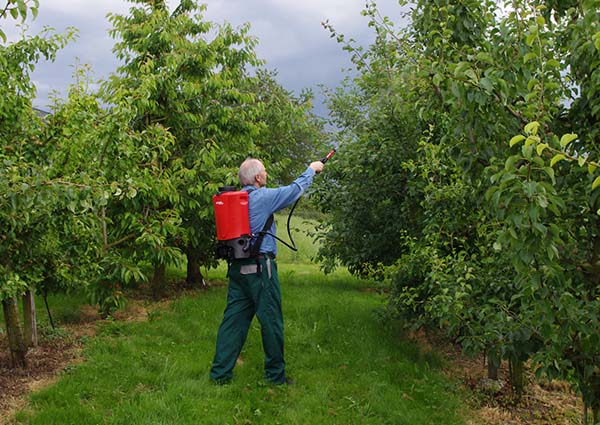
Note! It is believed that foliar feeding is most effective when the plant especially needs certain trace elements (which is manifested in its appearance), in other words, they are carried out as needed.
However, the effectiveness of such dressings still largely depends on weather conditions, namely: it should be calm, and the temperature should not be higher than 25 degrees. Therefore, as a rule, foliar feeding is performed early in the morning or in the evening.
- The most effective foliar dressing is spraying trees at the beginning of their flowering boron, eg, solution boric acid (1 gram per 10 liters) or with a special preparation Boroplus (the name is only similar to the famous cream). This trace element is noticeably improves fruit set (your future harvest) in unfavorable conditions, for example, if it is cool enough, so to speak, the weather is not flying for bees.
- The same urea (carbamide) it is even better to use it in the spring as a foliar nitrogen dressing (10-20 grams per 10 liters of water).
- You can also use complex fertilizers with macro and microelements in a chelated (quickly assimilated by plants) form... For example, the same Plantafid, AgroMaster from the Russian company Agromaster, Aquarin from the Buisk chemical plant (Buisk fertilizers).
By the way! You can do foliar feeding of the apple tree together spraying trees with pesticides against diseases and pests... As a rule, fertilizers can be added to solutions of fungicides and insecticides if there are no contraindications (for example, Bordeaux liquid better not to mix with anything).
Thus, foliar dressing, as a rule, is carried out with the help of fertilizers, which include trace elements, but fertilizers with basic macronutrients are often used (more often it is complex, in a rapidly digestible form).
It is worth understanding! Foliar dressing cannot completely replace root dressing. Therefore, the root is the main dressing, and the foliar is additional.
Features of feeding young and old apple trees
Young and already adults actively bearing apple trees need different feedings, more precisely, in their different concentrations (the larger the tree, the more it needs nutrition).
So when feeding young apple trees, the concentration of fertilizers is reduced by about 2 times.
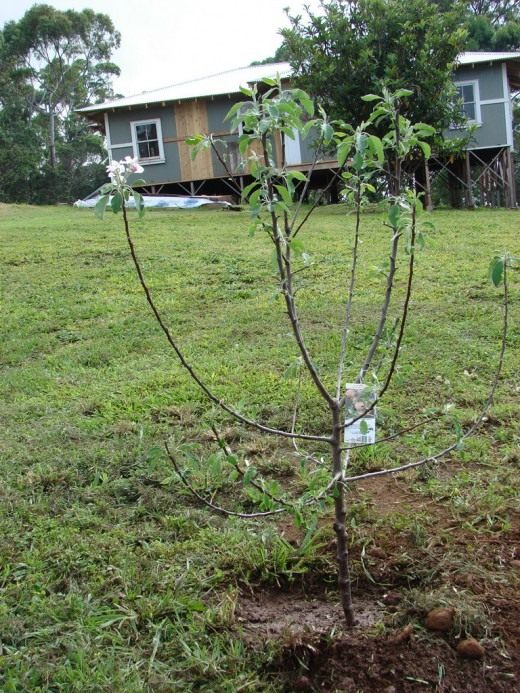
Clarification! Young - these are not yet fruit trees.
As a rule, apple trees begin to bear fruit in the 5-8th year.
By the way! If the tree still does not bloom and bear fruit, then about the reasons and solutions to the problem you can read here.
Old (adults) - these are trees that have already entered the fruiting phase (over 5-8 years old).
Video: rules for the use of fertilizers and types of fertilizing in the garden
How to feed an apple tree in spring for a good harvest: options for effective spring fertilizers
Naturally, before buying and fertilizing directly, you need to figure out how (with what fertilizer) you can and better feed the apple tree in spring.
As with many other crops, both mineral and organic fertilizers can be used to feed the apple tree.
Next, we will take a closer look at when and what fertilizers can be used, as well as how to combine them so that the apple tree receives all the necessary nutrition.
Note! It is not necessary to apply chlorine potash and phosphorus fertilizers under the apple trees in spring (for example, potassium chloride, potassium salt and diammophos). Such feeding can provoke plant disease. chlorosis.
Another thing is if they are brought in in the fall.
Mineral and organic nitrogen fertilizers
Remember! They are used only in spring (until late May-early June).
The fact is that nitrogen contributes to growth activity, so after June it is better not to add it to the soil, otherwise in winter the shoots may freeze.
Mineral nitrogen fertilizers:
- Urea (Carbamide) - 46% nitrogen (20-30 grams per 10 liters of water or per 1 square meter - with root feeding, if sprayed, then 10-20 grams per 10 liters of water);
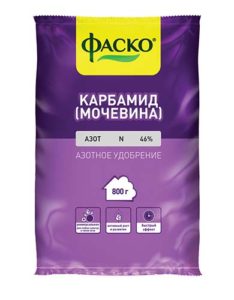
- Ammonium nitrate - 33% nitrogen (30-40 grams per 10 liters of water or per 1 square meter);
As a rule, about 50-70 grams should be applied for young trees (which do not bear fruit), and 150-180 grams for adults.
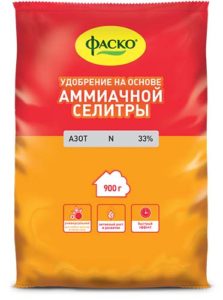
Important! Ammonium nitrate, upon contact with air, loses part of its nitrogen, so it must be embedded in the soil, or spilled, but not just scattered in the trunk circle.
Organic nitrogen fertilizers:
- Chicken droppings (as a rule, 1 in 20 with water, or you can simply sprinkle it in the trunk circle);
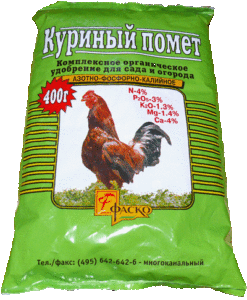
By the way! Please note that purchased poultry manure contains the entire range of macronutrients, as well as some trace elements.
- Infusion cow dung or mullein (1 in 40);
- Green manure (the same infusion of nettle).
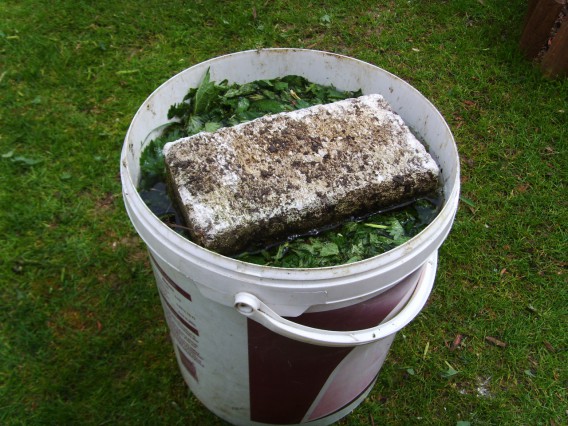
And also very good mulch trunk circle compost or humus.
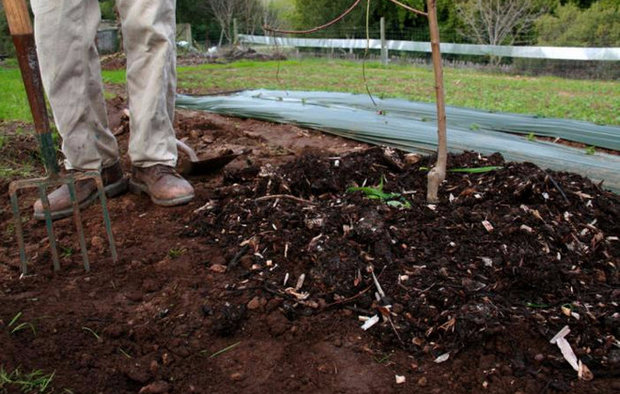
Complex (nitrogen-phosphorus-potassium) mineral feeding
It is very convenient to use complex mineral fertilizers, which contain all the macronutrients.
So, an apple tree in early spring (before flowering) can be fed with the following complete mineral fertilizers:
- Nitroammofosk or azofosk (nitrogen, phosphorus, potassium - all 16%) - 30-40 grams per 1 square meter (or 10 liters of water).
As a rule, about 50-70 grams should be applied for young trees, 150-180 grams for adults.
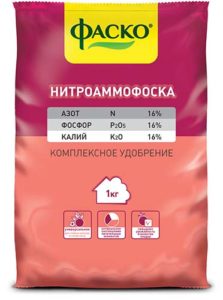
- Diammofoska - 10% nitrogen, 26% phosphorus and potassium (20-30 grams per 1 square meter or 10 liters of water).
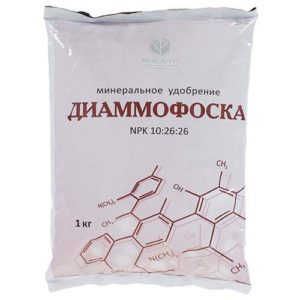
Note! The composition of these fertilizers does not include any trace elements, and it is very desirable to add them. Therefore, it is highly recommended to add the same humates to the solutions, which are described in more detail later, in the last paragraph.
Mineral and organic potassium-phosphorus feeding
Suitable for feeding in early spring (before flowering), as well as in autumn.
Mineral:
- Superphosphate - nitrogen 6-9%, phosphorus - 26-30% (30-40 grams per 1 square meter or 10 liters).
Advice! The site has a separate article about how to apply superphosphate.
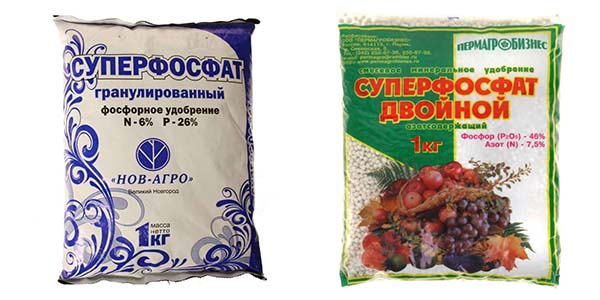
- Potassium sulfate (potassium sulfate) - 46-52% potassium (40-50 grams per 1 square meter or 10 liters).
Important! You need to be careful with potassium sulfate; in case of an overdose, you can provoke a root burn.
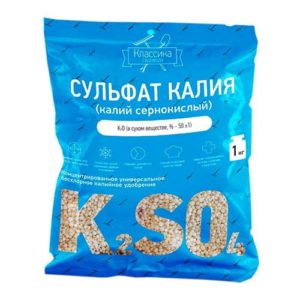
By the way! Instead of potassium sulfate (potassium sulfate), you can use potassium nitrate (Nitrogen -13.6%, Potassium 46%).
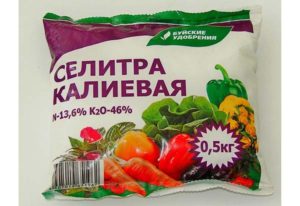
And it is also very convenient to use kalimagnesia, which, in addition to potassium (32%), contains such an important trace element as magnesium (12%).
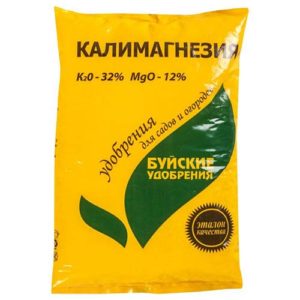
Organic potassium phosphorus supplement
If you proponent of organic farming, then you can as potash feeding use wood ash, having prepared the following solution (or even better infusion-extract): 100-200 grams of ash per 10 liters of water or per 1 sq.m.
By the way! IN ash also, as a rule, there is also calcium and a little phosphorus.
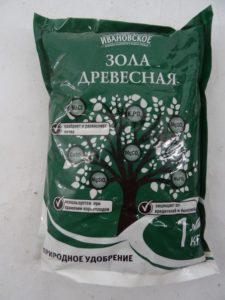
Concerning phosphorus, then it is available (up to 30%) in the same bone or fish meal (2-3 glasses per barrel circle or 100-200 grams per 1 sq. M.).
Interesting! Bone meal also contains a lot of calcium (up to 45%) and very little nitrogen (up to 1%).
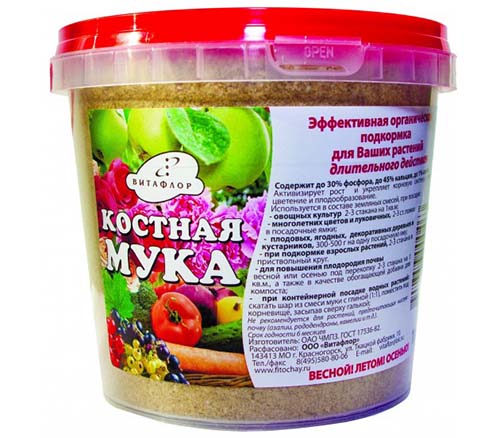
Video: feeding fruit trees with bone meal
Rapidly assimilated phosphorus supplement
Suitable for feeding before and after flowering.
To make an easily digestible infusion of superphosphate for spring feeding an apple tree, you need:
Take potassium monophosphate, dissolve in water and fertilize.
However, it is not always possible to find it in the store, and it costs a lot (expensive).
In this case, you can:
- 1 kg double superphosphate pour 5 liters of boiling water;
- after the water has cooled, add 0.5 liters of 9% vinegar;
Acidifying the water will help convert the calcium phosphate to a more soluble form.
- Let it brew for 12-24 hours, shaking and stirring occasionally.
- Add another 5 liters of water, bringing the total volume to 10 liters.
- Then dilute 1 liter of the superphosphate infusion with 10 liters of water (1 to 10).
- Carry out top dressing.
Advice! The remaining phosphorus sediment can be dug under other fruit trees.
Autumn potassium-phosphorus fertilizing (after harvest)
The following combinations of mineral and organic fertilizers can be an excellent option for feeding an apple tree after fruiting and harvesting (i.e. at the end of summer - in autumn).
By the way! The site has a detailed article abouthow and what to feed the apple tree after fruiting and harvesting (in the fall).
First option:
- Superphosphate - nitrogen 6-9%, phosphorus - 26-30% (40-50 grams per 1 sq. M or as a spraying on a leaf - 30-40 grams per 10 liters of water).
As a rule, about 70-100 grams should be applied for young trees, 150-200 grams for adults.

Or double superphosphate (nitrogen 7.5-10%, phosphorus 46%). But the dose should be reduced by 1.5-2 times.
- Potassium sulfate (potassium sulfate) - 46-52% potassium (20-30 grams per 1 square meter or 10 liters).
As a rule, about 40-60 grams should be applied for young trees, 80-100 grams for adults.

Second option:
- Diammofoska - 10% nitrogen, 26% phosphorus and potassium (20-30 grams per 1 square meter or 10 liters).

Third option:
- Borofoska (Phosphorus - 10%, potassium - 16%, calcium - 20%, magnesium - 2%, boron - 0.25%) - 30-40 grams per sq.m. or 10 liters.
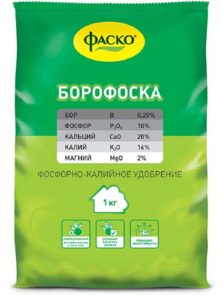
Fourth option:
- Potassium monophosphate (Phosphorus - 50%, potassium - 33%) - 20-30 grams per square meter or 10 liters.
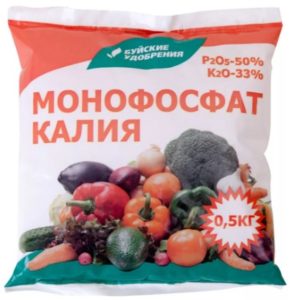
Ready-made fertilizers for apple (fruit and berry crops), including fast-digesting and in chelated form
If you do not want to bother (you are a "lazy" summer resident), then you can buy one of the special complex fertilizers for apple (fruit trees), which already contains all the macro- and microelements (all apply and dilute according to the instructions on the packages):
- Gumi-Omi "Fruit trees and shrubs" (compost based on chicken manure).
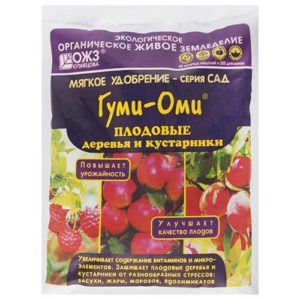
- Specialized fertilizers are especially popular prolonged action (granular, it is desirable to add them dry into the holes along the projection of the tree crown, and then water). For example, "Spring"From"Fasco ".
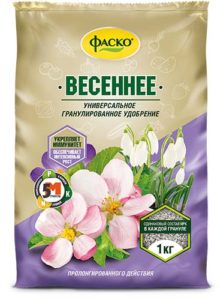
- Aquarine "Fruit and Berry" from "Buy Fertilizers" (quickly assimilated, microelements in a chelated form, can be applied starting from the flowering phase, as well as foliar dressing).
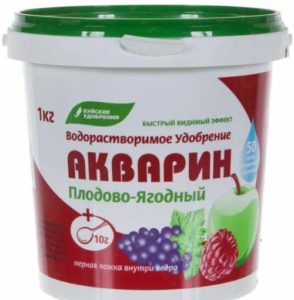
- Plantafid from "Agromaster" (quickly assimilated, contains microelements in a chelated form, ideal for foliar dressing at different periods of plant development, depending on the need, starting from early spring, before flowering, during flowering and after).
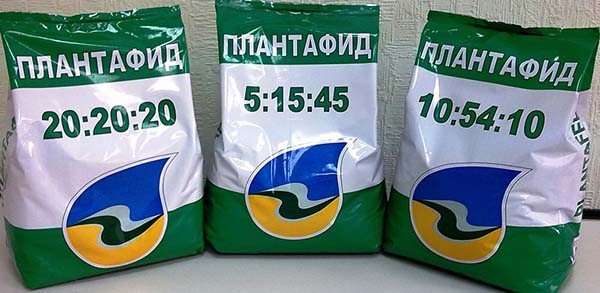
- Hera "Orchard" other.
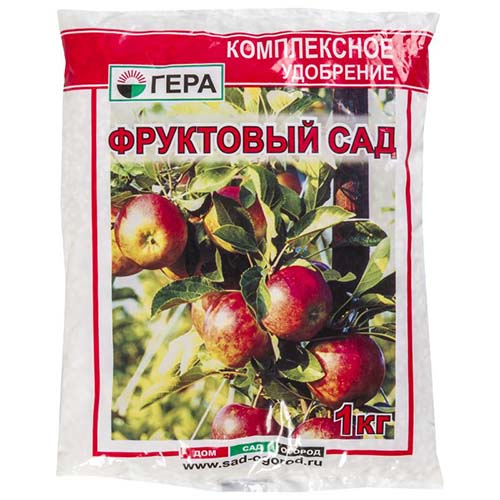
Fertilizers with humates and microelements
Very good to use humateswhich contribute to better absorption of mineral fertilizers. Therefore, you can first prepare a humate solution (for example, Potassium humate), and then add a complex mineral fertilizer to it, for example, the same Nitroammofosk or Diammofosk.
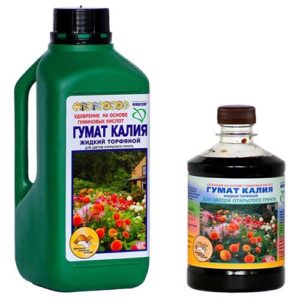
By the way! Now humates are initially added to some complex mineral fertilizers. For example, "Strong " from Fasco with potassium humate and trace elements.
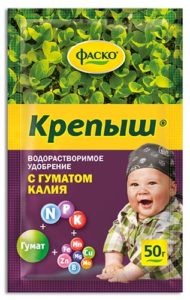
In general, it is very convenient to use for foliar feeding of an apple tree ready-made cocktails with essential microelementstype Humate +7 Iodine.
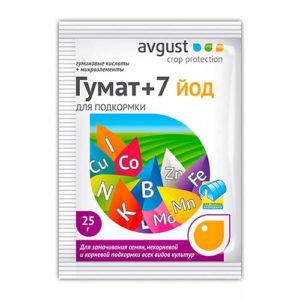
What else needs to be done in the spring to get a good harvest of apples
The spring apple tree care activities include the following:
- opening after winter (removal of the winter shelter);
- whitewash (although it is necessary to whitewash in the fall or at the very end of winter or early spring);
- spring pruning;
- graft;
- loosening and weeding;
- watering;
- direct feeding;
- mulching;
- treatment against diseases and pests.
By the way! The site also hasgeneral detailed article about spring apple tree care.
Thus, now you know the better, when and how to feed apple trees in spring, summer and autumn in your garden so that your fruit trees are strong and healthy, which means they can bear fruit abundantly every year.
Video: how and what to properly fertilize fruit trees (including apple trees)


Thank you very useful information! The process of caring for apple trees is comprehensively described and explained.
The material is presented competently, convincingly and intelligibly.
All the best!
Thank you very much! Very useful and accessible information especially for novice gardeners! And from the photo it is easy to find the right fertilizer in the store.